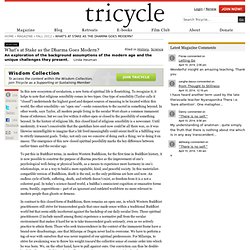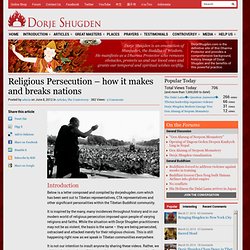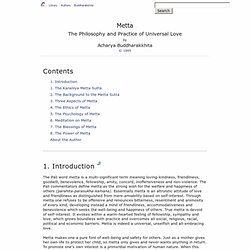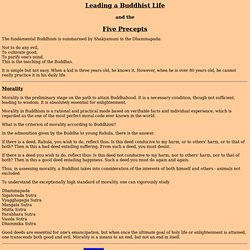

Zen master Thich Nhat Hanh: only love can save us from climate change. Zen master Thich Nhat Hanh, one of the world's leading spiritual teachers, is a man at great peace even as he predicts the possible collapse of civilisation within 100 years as a result of runaway climate change.

The 86-year-old Vietnamese monk, who has hundreds of thousands of followers around the world, believes the reason most people are not responding to the threat of global warming, despite overwhelming scientific evidence, is that they are unable to save themselves from their own personal suffering, never mind worry about the plight of Mother Earth. Thay, as he is known, says it is possible to be at peace if you pierce through our false reality, which is based on the idea of life and death, to touch the ultimate dimension in Buddhist thinking, in which energy cannot be created or destroyed. Look beyond fear "Our perception of time may help," Thay told me in his modest home in Plum Village monastery near Bordeaux. Confront the truth "They want to get busy in order to forget. What's at Stake as the Dharma Goes Modern? In this new ecosystem of secularism, a new form of spiritual life is flourishing.

To recognize it, it helps to note that religious sensibility comes in two types. One type of sensibility (Taylor calls it “closed”) understands the highest good and deepest sources of meaning to be located within this world; the other sensibility—an “open one”—seeks connection to the sacred in something beyond. Monthly returning special days for practice - Tibetaans boeddhisme. Religious Persecution – how it makes and breaks nations : Dorje Shugden and Dalai Lama – Spreading Dharma Together. Introduction Below is a letter composed and compiled by dorjeshugden.com which has been sent out to Tibetan representatives, CTA representatives and other significant personalities within the Tibetan Buddhist community.

Mr. S.N. Goenka. When there is darkness, light is needed.

Today, with so much agony caused by violent conflict, war and bloodshed, the world badly needs peace and harmony. This is a great challenge for religious and spiritual leaders. Let us accept this challenge. Every religion has an outer form or shell, and an inner essence or core. Recollection of the Buddha. Death & Legacy, part 2. Death & Legacy Today, Kushinagara is revered by pilgrims as the place where the Buddha finally left the world of endless suffering.

It was in Kushinagara where he grew weak, and asked to be laid on his side in a quiet grove of sal trees. As he neared the end, his disciples began to weep, stricken with grief. But the Buddha reassured them: Pilgrims at Kushinagara David Grubin Productions View Larger View on Timeline/Map “All things change. Mark Epstein, psychiatrist: "He’s saying this is a natural process. W.S. Jane Hirshfield, poet: "It’s all right to feel what human beings feel and we are not supposed to turn into rocks or trees when we practice Buddhism. The Bhikkhus' Rules: A Guide for Laypeople. Precepts The awakened mind has gone beyond greed, hatred and delusion.

Yet for those of us who are still striving towards this end such unskillful tendencies have to be addressed. We need guidelines to help us become more aware of our actions and speech, so that we do not go off the Buddha's Middle Way. For a start there are the Five Precepts, then the Eight and the Ten Precepts, [see End Note 4] and then the 227 Paa.timokkha Rules of the bhikkhu. The Five Precepts are basic human ethical standards — answering the fundamental questions of 'what do I do, what should I say? ' The Vinaya and Paa.timokkha rules were set down by the Buddha in response to specific incidents that occurred either within the Community of bhikkhus or through their interaction with the lay community. When a bhikkhu takes up the training rules, he might find that past habits and tendencies still cause problems — especially in a non-supportive environment.
Bhikkhus Becoming a Novice. Emptiness and Compassion. Wisdom. 'I am not, I will not be.

I have not, I will not have. Metta: The Philosophy and Practice of Universal Love. The Pali word metta is a multi-significant term meaning loving-kindness, friendliness, goodwill, benevolence, fellowship, amity, concord, inoffensiveness and non-violence.

The Pali commentators define metta as the strong wish for the welfare and happiness of others (parahita-parasukha-kamana). Essentially metta is an altruistic attitude of love and friendliness as distinguished from mere amiability based on self-interest. Through metta one refuses to be offensive and renounces bitterness, resentment and animosity of every kind, developing instead a mind of friendliness, accommodativeness and benevolence which seeks the well-being and happiness of others. True metta is devoid of self-interest. It evokes within a warm-hearted feeling of fellowship, sympathy and love, which grows boundless with practice and overcomes all social, religious, racial, political and economic barriers.
Metta makes one a pure font of well-being and safety for others. Leading a Buddhist Life - Five Precepts. Leading a Buddhist Life and the Five Precepts The fundamental Buddhism is summarised by Shakyamuni in the Dhammapada: Not to do any evil, To cultivate good, To purify one's mind, This is the teaching of the Buddhas.

It is simple but not easy. Church Of Shambhala Vajradhara Maitreya Sangha. Buddhism in the Numbers. BUDDHISM IN THE NUMBERS Rev.

Jnana - Zen Dharma Teacher - IBMC A Dharma Talk at the IBMC --- The rather inelegant title of today’s talk, “Buddhism in the Numbers”, does an injustice to the elegance of the subject itself, the role of numbers in communicating the dharma. For there is indeed a rich vein of numerical references in Buddhism, primarily in the sutras, but also in related doctrines and teachings. My purpose here this morning is to briefly mine that vein, to bring a greater degree of awareness to the place of numbers that permeate so much of our study and devotion along the Buddhist path. Giving Through Relationships. Mutual causality in Buddhism and ... Guide to the Hidden Land of Yolmo - Rangjung Yeshe Wiki - Dharma Dictionnary. By Khenpo Nyima Dondrup. In Buddha's Hood. Tricycle.
Eofe. Dhammacakkappavattana. Buddha crime. Buddhism and the problem of crime By Bandula Jayawardhana Formerly Editor in-Chief Encyclopaedia of Buddhism "CRIME" is a word we use today to denote any offence against a community as a whole, or one (or more) of its members. At the same time implicit in our use of it, is the sense that it is punishable, or deserving of punishment by a socially-recognised authority. The traditional literature of Buddhism does not seem to possess a word which identically fits our meaning, idle and futile as it is to seek for an equivalent in a religious system with its own highly specialized terminology and its own historical and geographical background. Buddhism, in fact, does not seem to deal with this subject anywhere, doctrinally. Buddhist Studies: The Eight Auspicious Symbols. Three Jewels. The Three Jewels are:[1] Buddha. Cultivating Insight into the Nature of Things as They Are.
THE FRUITION OF BUDDHIST PRACTICE is the realization of the three kayas--Dharmakaya, Sambhogakaya, and Nirmanakaya. These are the three bodies of Buddha's being or enlightenment. Dharmakaya corresponds with one's mind, Sambhogakaya with one's speech, and Nirmanakaya with one's body. Dharmakaya is the formless body. It is an undifferentiated state of being which we cannot talk about in terms of either confusion or enlightenment. The 3 Kayas. The 3 Bodies of the Buddha [trikaya] Trikaya is a Sanskrit word used in the Buddhist context to refer to levels of manifestation or activity.
Tri means three and trikaya as a concept concerns three levels of buddhahood. Death and Dying in the Tibetan Buddhist Tradition. 039;s Buddhist Studies: History and Culture. Buddhist Statistics: Top 10 Buddhist Countries, Largest Buddhist Populations. Country Review. Buddhism and the Illusion of Time. Buddhist Anarchism (Gary Snyder) Buddhism & Social Solutions. Thank you for that response, that is very interesting. Green Buddhism. Green Buddhism and the Hierarchy of Compassion Alan Sponberg (Dharmachari Saaramati) San Francisco Zen Center.
5609. ² bodycard 0055. Bodycard 0055.